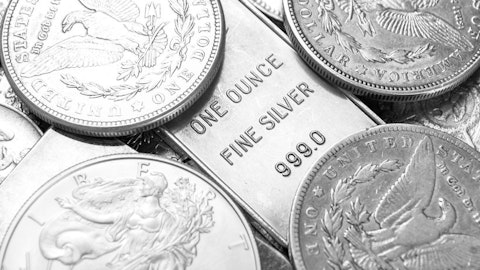Tristan Gresser: Just have one left. It’s on capital allocation. I think in your prepared remarks, you flagged a $3 billion net debt target that you expect to reach at some point this year, if I understood correctly. So what’s the strategy after that? I think you talked about the strong electrical steel market, but you fine with your capacity, you fine with the metallics your supply there as well. You flagged some decarbonization needs, but — are there more investment coming? Or will free cash flow generation will be more tilted towards shareholder returns after that — after we reach that point? And also is the net debt-to-EBITDA reference point you have below onetime? Is it still valid?
Lourenco Goncalves: We didn’t flag anything that we said that we flagged. So let’s correct the record. We talked about projects that are multiyear, and we are conflicting everything for the cash flow that your are going to have this year and our target of getting to net debt down to $3 billion this year. So the only thing that we said that you will do, take notice, please, Tristan. We are going to get to net debt at $3 billion later this year, still this year. That’s what we said. The carbon capture project is future. The hydrogen project is future because we still don’t have hydrogen. The relining of Indiana Harbor is in 2025. We are in 2023. So one more time, we flagged that we’re going to get to net debt, $3 billion this year. Before Santa Claus came to your home, you’re going to be with $3 billion net debt. What else can I do for you, Tristan?
Tristan Gresser: Sorry, if I — my question wasn’t clear then after you get to that milestone, what’s you thinking? What’s the strategy?
Lourenco Goncalves: Your question was clear. Your understanding was wrong. So that’s why I’ve corrected your assessment. But after we get to $3 billion, we will see. We haven’t said anything about it. I’m not going to tell you at this point. But usually, companies at that point, tend to increase return to the shareholders. But return to the shareholders can happen earlier, whereas my stock price is on sale in the stock exchange as soon as the window opens, I might be buying stock. I myself as CEO, I’m going to buy a lot of stock as soon as the window opens. So because it’s on sale. It’s on sale because people don’t understand long term. They believe that 3 months, a quarter is long term, it’s not. In our business, it’s a New York minute. Okay, Tristan?
Operator: Our next questions come from the line of Alex Hacking with Citi.
Alexander Hacking: I just wanted to follow up on the cost guidance. I think in the last quarter also, you had guided to maybe $60 of cost decreases in 2Q and then another $40 in 3Q. And now we’re looking, I think, at $20 in 2Q. I understand it’s extremely difficult to forecast. I guess what changed in the forecast? And should we still be expecting cost decreases to flow into the third quarter and potentially the fourth quarter as well.
Celso Goncalves: Yes. Sure. Alex, let’s drill down on that because it’s important. So since we gave that guide, scrap prices, for example, have gone up around $100. So things change, right? And like I said, we guided to $50 cost reduction in Q1, and we executed $60. So there’s a little bit of pull forward there. And we, as you said, had guided to another $60 in Q2, and now I’m saying, call it, $15 to $20. And the bridge between that $60 is $15 is largely driven by that change in scrap. But beyond Q2, we will see further cost reductions as well. So even though I’m seeing $15 to $20 here in Q2, Q3 is also going to have further cost reductions, call it, another $25. So it’s still significant meaningful cost reduction. It’s just the timing, like you said, it’s hard to nail down.
Alexander Hacking: Okay. I appreciate the color, and I understand Metallic is a moving target and hard to forecast. And then I guess just on the shipment side, obviously, extremely strong in the quarter to auto and also outside of auto. Is there any — is there any part of that you think is restocking? Or do you think this reflects where true underlying demand is and the weakness that we saw at the end of last year was really just driven by destocking?
Lourenco Goncalves: In our case, Alex, all the fluctuations that we are seeing are coming from end users, particularly coming from automotive. Automotive is buying more. SAAR is higher now than it has been in a long time. It’s not back to where it should be, but the consumer continues to buy cars. They continue to produce cars at the OEM level. They continue to push cars into the lots of the dealers, and we continue to sell steel for them to build these cars. So this north of 4 million tons a quarter pace that we are in right now is supported basically, I would say, exclusively by automotive demand in our case. All the rest is just greedy. Service centers are continuing to operate at low levels of inventory. And if they see something different coming next week when the Fed will speak, they probably will buy more.
I am anticipating car manufacturers continue to buy strong and service centers will be left behind if they don’t start to change their pace. It’s not bad, but it’s not great at this point.
Alexander Hacking: Okay. I appreciate the color as always.
Operator: Our next question is come from the line of Sean Wondrack with Deutsche Bank.
Sean Wondrack: Just first question. When you think about sort of green energy and some of the opportunities you’re pursuing, do you see any other tangential opportunities, whether it’s within solar or wind or even charging infrastructure that we could look forward to in the next few years?
Lourenco Goncalves: Yes. Look, we sell to clients in this submarket, and we are seeing demand coming from them. We believe that money is coming from inflation Reduction Act will — and the infrastructure bill will support more and more investment in these areas. But at this point, it is still very — is at the very beginning of the development of this submarket. One thing that I believe will pick up steam very quickly is the deployment of capital in charging stations because the states are starting to move faster on that, and that will create more opportunities for us, not only for grain-oriented electrical steels, obviously, but also for other types of steel because the charging stations consume steel, not only electrical steels, like normal carbon steel that we produce and sell. So these are mainly the best points of increased consumption that we see right now.





